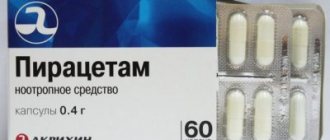Pharmacological properties
Lyrica is a drug with antiepileptic and anticonvulsant activity. The active component of the drug is pregabalin - an alkylated analogue of gamma-aminobutyric acid, however, despite the structural similarity of the molecules, pregabalin does not have the activity characteristic of gamma-aminobutyric acid. Pregabalin has neither direct nor indirect GABAergic effects. The mechanism of action of the drug is based on its ability to bind to the alpha-2-delta subunits of neuronal calcium channels (N- and P/O-type calcium channels), resulting in a decrease in calcium transport into neuronal cells in response to the action potential. The drug is characterized by a high degree of affinity for alpha-2-delta protein located in the tissues of the central nervous system. The use of the drug leads to a decrease in the release of pain neurotransmitters (including glutamate, norepinephrine and substance P) into the synaptic cleft when neurons are excited. Due to such changes, under the influence of the drug, impulse conduction is selectively suppressed; it should be noted that the drug Lyrica suppresses the excitability of the neuron network only under pathological conditions.
The drug has an analgesic effect for pain of neuropathic etiology and postoperative pain syndrome, including conditions such as hyperalgesia and alodynia. The drug in a therapeutic dose is well tolerated by patients; during studies, the absence of a teratogenic effect was noted when the drug was used in doses 2 times higher than the therapeutic one. As a result of a number of studies, the absence of carcinogenic and genotoxic effects of pregabalin was noted. After oral administration, the drug is well absorbed from the gastrointestinal tract, the peak concentration of the active substance in the blood plasma is observed 1 hour after oral administration of the drug. With repeated use of Lyrica, the time to reach the maximum plasma concentration of the active substance does not change. The bioavailability of the drug does not depend on the dose taken and is about 90%. With repeated use of the drug, equilibrium concentrations of pregabalin are achieved within 24-48 hours. Eating reduces the rate and degree of absorption of pregabalin, so when taking the drug simultaneously with food, the time to reach the peak of the active substance in plasma increases by 2.5 hours, and the maximum plasma concentrations of the drug are reduced by 25-30% (compared to the data obtained after administration drug on an empty stomach). It should be noted that food intake does not have a clinically significant effect on the amount of absorption. The drug does not bind to plasma proteins. Pregabalin penetrates well through the blood-brain and hematoplacental barriers and is also excreted in breast milk. A small part of the drug (less than 1%) is metabolized to form an N-methylated compound. The drug is excreted unchanged in the urine. About 1% of the drug is excreted in the urine as a metabolite. The half-life of the drug is 6.3 hours. It should be noted that pregabalin clearance is directly proportional to creatinine clearance. In patients taking antiepileptic drugs and patients suffering from chronic pain syndrome, pharmacokinetics are similar to those in healthy volunteers. In patients suffering from impaired renal function, dose adjustment is necessary. The decrease in pregabalin clearance in patients with renal failure is directly proportional to the decrease in creatinine clearance. Patients with reduced creatinine clearance need to reduce the dose of Lyrica, and patients on hemodialysis need to increase the dose of pregabalin after a hemodialysis session (after 4 hours of hemodialysis, about 50% of the dose of the drug is removed from the blood plasma). In patients suffering from liver failure, dosage adjustment of the drug is usually not required, since pregabalin is metabolized in small quantities, and impaired liver function does not have a significant effect on the pharmacokinetics of the drug. In elderly patients, there is a decrease in the clearance of creatinine and pregabalin; it is recommended to adjust the dose of Lyrica in patients with age-related renal impairment.
What is Lyrica
Lyrica is the trade name for the drug pregabalin. It is used as an antiepileptic drug and also to relieve neuropathic pain, such as spinal cord injury or fibromyalgia.
Thanks to its strong analgesic effect, pregabalin is also widely used in drug addiction – it is used to relieve pain during heroin withdrawal.
But pregabalin has another effect: it causes a feeling of euphoria. It is this property that turns a useful medicine into a drug.
People most likely to become dependent on Lyrica are those taking the drug for medical reasons as a pain reliever. Addiction can develop even if the dosage is strictly followed.
It is not uncommon for a drug addict to “get off” heroin or methadone and switch to Lyrica. At the same time, relatives are ready to buy pregabalin for the patient themselves, not suspecting that they are only taking addiction to a new level.
Directions for use and dosage
Lyrica is taken orally; it is recommended to swallow the capsule whole, without chewing or crushing, with a sufficient amount of water. The drug is taken regardless of meals. The duration of the course of treatment and the dose of the drug are determined by the attending physician individually for each patient, depending on the nature of the disease and the patient’s personal characteristics. Adult patients suffering from neuropathic pain are usually prescribed the drug at an initial dose of 75 mg 2 times a day. If necessary, the dose is gradually increased to 150 mg 2 times a day (this dose is optimal for most patients with pain of neuropathic etiology). Some patients, depending on individual sensitivity to pregabalin and the severity of the disease, require higher doses of the drug. In this case, the dose is first gradually increased to 150 mg 2 times a day, then the dose can be increased to 300 mg of the drug 2 times a day (an interval of at least 7 days must be maintained between each dose increase). The maximum daily dose of the drug is 600 mg. The therapeutic effect develops within a week after starting to use the drug. The duration of the course of treatment is determined by the attending physician. After completing the course of treatment, the drug is discontinued by gradually reducing the dose over at least 7 days. Adults and adolescents over the age of 12 years with epilepsy are usually prescribed the drug at an initial dose of 75 mg 2 times a day. A week after the start of therapy, if necessary, the dose of the drug can be increased to 150 mg 2 times a day. Further dose increases, if necessary, are carried out 7 days after the previous dose increase. The maximum daily dose of the drug is 600 mg. The duration of the course of treatment with the drug is determined by the attending physician. For patients taking other anticonvulsants, no dose adjustment of pregabalin is required since the drug does not affect the concentrations and pharmacological effects of other anticonvulsants. Discontinuation of Lyrica should be gradual over a period of at least 7 days. For patients with impaired renal function, the dose of the drug is determined depending on the creatinine clearance: Patients with a creatinine clearance of more than 60 ml/min are usually prescribed the drug at an initial daily dose of 150 mg. The maximum daily dose of the drug is 600 mg. It is recommended to divide the daily dose of the drug into 2 doses. Patients with creatinine clearance from 30 to 60 ml/min are usually prescribed the drug at an initial daily dose of 75 mg. The maximum daily dose of the drug is 300 mg. It is recommended to take the daily dose of the drug at one time or divide it into 2 doses. Patients with a creatinine clearance of 15 to 30 ml/min are usually prescribed the drug at an initial daily dose of 25-50 mg. The maximum daily dose of the drug is 150 mg. It is recommended to take the daily dose of the drug at one time or divide it into 2 doses. Patients with creatinine clearance less than 15 ml/min are usually prescribed the drug at an initial daily dose of 25 mg. The maximum daily dose of the drug is 75 mg. It is recommended to take the daily dose of the drug at one time. For patients suffering from impaired renal function who are on hemodialysis, it is recommended to prescribe an additional dose of Lyrica after a hemodialysis session (since about 50% of the taken dose of pregabalin is removed from the blood plasma during a 4-hour hemodialysis session). Typically, at the beginning of treatment, the additional dose of pregabalin after hemodialysis is 25 mg, but depending on the individual sensitivity of the patient to the drug, the dose can be gradually increased to 100 mg. Patients suffering from impaired liver function do not need dose adjustment of Lyrica. If it is necessary to use the drug in elderly patients, it is recommended to check renal function before starting the use of pregabalin. Elderly patients with normal renal function do not require pregabalin dose adjustment.
Medical therapy
Treatment for a drug addict taking Lyrica is virtually no different from therapy for a heroin and other drug user. It can be roughly divided into two stages:
- removing the drug from the body, cleansing it, replenishing the lack of fluid;
- further therapy, including withdrawal symptoms, drug treatment, and psychological rehabilitation.
After the drug is removed from the body and withdrawal symptoms are eliminated, it is important to conduct a comprehensive examination. This will allow you to understand what you need to pay attention to. Most often, drug addicts suffer from liver, kidneys and heart.
DRUG ADDICTION TREATMENT IN MOSCOW
The most difficult stage is not physiological, but psychological - the drug can be easily removed from the blood, but it is very difficult to remove it from consciousness. Psychotherapy is mandatory for all patients. Sessions with a specialist or in a group will help to cope with a person’s internal problems, which often lead to drugs.
Leave a request for a free consultation with a specialist
We will contact you as soon as possible
- — Anonymous
- - For free
- — Around the clock
Another difficulty is returning to normal life, because outside the clinic the likelihood of buying a drug is at every turn. It is best to continue psychotherapy sessions for an addicted person regularly throughout life. They are also necessary for family and friends - often parents, husbands, wives, brothers or sisters become codependent and do not know how to behave correctly.
Article verified by an expert
Barinov Alexander Mikhailovich
More than 10 years of experience working with alcohol and drug addicts.
Similar articles:
Beer alcoholism: symptoms and consequences
Drug addiction and alcoholism. How family influences the formation of addiction
How fears strengthen codependency
The effect of opium on the body
Is it possible to de-register with a narcologist early?
to “Lyrics - a drug or a medicine?”
- Yaroslav:
November 20, 2021 at 09:21
The drug Lyrica is nothing more than a medicine used to combat pain and cramps. To be precise, Pregabalin, also known as Lyrica, is an antiepileptic drug. It is a strong pain reliever.
Answer
- Lyubov Uspenskaya:
November 27, 2021 at 06:30
The pregabalin molecule, being an analogue of GABA, binds to the additional subunit (?2?) of voltage-gated calcium channels in the central nervous system, which contributes to the manifestation of analgesic and anticonvulsant effects. A decrease in seizure frequency begins within the first week.
Answer
- Yana:
December 23, 2021 at 01:56 pm
I just can’t understand how you manage to write such interesting notes.
Answer
- Vladimir:
January 28, 2021 at 02:39 pm
An indispensable remedy for neuropathy. The only thing that helps relieve severe pain.
Answer
- Boris:
February 8, 2021 at 16:03
Tell me, how does the analgesic effect of Lyrica manifest itself - immediately after ingestion or after a course of administration?
Answer
- Elena:
May 8, 2021 at 08:39 pm
Lyrica is not a therapeutic drug, but a symptomatic one. Helps very well with neuropathic pain. The pain goes away, but the pathology remains, REMAINS. A herniated disc can only be cured surgically; other types of supposed treatment involve eliminating pain for a short period of time. Personally, two 75 mg capsules twice a day are enough for me. In the morning and in the evening. For a drug addict, this dosage is “a drop in the bucket.” They can always find this drug in a pharmacy without a prescription, 300 mg capsules. Two per appointment. But people with pain syndrome may not even get a prescription. Pharmacists find errors in the prescription every time. They take away the recipe, and you’re left with “butter.” Corruption is all around. At the doctor, at the pharmacist. I didn't even know what was written in my medical history. You'll never know what prescription you've been given. There is one dosage in the medical history, and another in the prescription. And the discharge date doesn’t match. I’m HORROR!
Answer
- Dmitriy:
September 26, 2021 at 10:02 pm
To everyone who will read this article after they have been prescribed Lyrica or Convalis. Yes, the drugs are quite powerful and have consequences. Unfortunately, the neurologist prescribes only a course of complex treatment. hepabeptin, Lyrica, injections, vitamins B1 and B6, etc. Amitriptyline goes there too. None of the above will relieve pain immediately. The pain is relieved by a set of measures and course. Those. when you come in with severe pain, there is a 99% chance you will come out without a short-term solution. They will tell you to hold on, the pain will go away in a month (or maybe in 6). See for yourself in the direction of distracting ointments. Perhaps they will prescribe a Versatis patch, it is expensive, and if the pain is severe(!), the reduction does not justify the price. Moreover, after the patch there is a 12-hour break and it will hurt. Strong painkillers (or God forbid tramadols, etc.) are generally when things are really bad. Look towards oflomelid (if the damage is not severe) or gevkamen (this one remarkably relieves pain, costs 50 rubles), but not a single doctor talks about it. Also be sure to consult a dermatologist and neurologist. Don't take my comment as a ready-made solution.
Answer
- oksana:
September 27, 2021 at 11:20 am
Thank you for the recommendations for users, but it is worth remembering that this cannot in any way replace going to the doctor and making a diagnosis. Everything is individual. Health to everyone!
Answer
Dmitriy:
September 27, 2021 at 10:42 pm
Oksana, of course, this is exactly what is written at the end of my comment. What has been written applies specifically to those who have already received a neurological diagnosis. pain in fact (I was stunned that they were prescribed something like lyric) and is trying to figure out how to reduce it (the pain). In my case, none of the 6 doctors gave an answer on what to do right then and there. I’ll add one more thing on my own behalf. If opportunities allow, take expensive analogues from imp. manufacturers. Yes, the substance is the same, but the purity and method of delivery can be completely different. I won’t give specifics, lest they be considered advertising, but in my case the difference was strong. At the same time, it is simply impossible to buy them in a pharmacy near your home, no.
Answer
- Vladimir:
September 30, 2021 at 09:31 pm
For some reason, everyone is silent about Cymbalta. For example, my doctor prescribed Lyrica and Cymbalta to drink at the same time. I have polyneuropathy. The pain is partially relieved. The doctor said that Lyrica should be added per capsule. I tried to add it, but at the same time my head and temples were compressed on the sides. I didn't drink the second one. I don’t know how long to take it. Everyone around, both doctors and people, say we need to get away from this nasty thing. As much as we are doctors, we have in common so many different opinions. One
Answer
Side effects
The use of the drug Lyrica is usually well tolerated by patients, however, in isolated cases, side effects may develop (it is possible that the development of side effects is associated with the course of the underlying disease): From the gastrointestinal tract: appetite disturbances (both increased appetite and anorexia), dry mouth, nausea, vomiting, stool disorders, flatulence. In addition, the development of hypersalivation, oral hypoesthesia and gastroesophageal reflux is possible. In isolated cases, patients experienced the development of pancreatitis, hypoglycemia, ascites and dysphagia. From the cardiovascular system and hematopoietic system: tachycardia, neutropenia, hyperemia and flushing, first degree atrioventricular block, changes in blood pressure. In isolated cases, the development of sinus arrhythmia is possible (the development of both tachycardia and bradycardia was noted). From the central and peripheral nervous system: dizziness, headache, drowsiness, ataxia, decreased attention, impaired coordination, euphoria, increased irritability, confusion. In addition, it is possible to develop a violation of mnestic function, memory loss, tremor, dysarthria, paresthesia, speech impairment, difficulty finding words, anxiety, and depersonalization. Some patients experienced the development of sleep disorders, including insomnia and unusual dreams. When using the drug, patients experienced sudden mood swings, depression, causeless anxiety, hallucinations, apathy, high spirits, psychomotor hyperactivity, hyperesthesia, decreased reflexes, dyskinesia, and the development of an acute anxiety state with a panic reaction. In isolated cases, hypokinesia, diplopia and parsomia may develop. From the senses: impaired taste sensitivity, hyperacusis, visual impairment, including diplopia, dry eyes, decreased visual acuity, lacrimation, asthenopia, eye pain. In isolated cases, the development of photopsia, eye irritation, mydriasis, peripheral vision impairment, oscillopsia and strabismus was noted. From the respiratory system: respiratory failure, dry mucous membranes, cough, rhinitis, nasopharyngitis, snoring. In addition, nosebleeds and a feeling of constriction in the throat may develop. From the musculoskeletal system: muscle fasciculation, cramps, muscle and joint pain, joint swelling, muscle stiffness, pain in the back and limbs. In isolated cases, the development of neck muscle spasm and rhabdomyolysis was noted. From the genitourinary system: decreased amount of urine, development of renal failure, urinary incontinence, erectile dysfunction, ejaculation disorders, amenorrhea, dysmenorrhea, decreased or increased libido, anorgasmia. Allergic reactions: skin rash, itching, urticaria, papular rash. Others: increased sweating, soreness and hypertrophy of the mammary glands, discharge from the mammary glands. When using the drug, there is a change in some laboratory test parameters, including an increase in the activity of hepatic transferases, an increase in the concentrations of creatinine and glucose in the blood, a decrease in the number of platelets and leukocytes in the blood, and hypokalemia.
Indications for taking pregabalin
- Neuralgia diabetic, postherpetic.
- Polyneuropathy with pain syndrome.
- Fibromyalgia.
- Myalgia (muscle pain).
- Inflammatory processes of the nervous system that occur with pain.
- Persistent pain that is unresponsive to traditional therapy.
- Epilepsy, convulsive syndrome.
- Generalized anxiety disorder.
- Withdrawal syndrome in addiction to psychoactive substances.
It is used in long courses of several weeks. It is practically not metabolized in the body (not included in metabolism) and is excreted unchanged in the urine.
Pregnancy
Due to the lack of reliable data on the safety of the use of pregabalin during pregnancy, Lyrica can only be used under the strict supervision of the attending physician, who, before prescribing the drug, must carefully weigh the expected benefits for the mother and the potential risks for the fetus. Before starting the use of Lyrica, it is recommended to exclude pregnancy; during pregabalin therapy, women are advised to use reliable contraception. Experiments revealed the excretion of pregabalin in rats through breast milk. There is no data on the excretion of the drug in breast milk in humans. If it is necessary to prescribe the drug during lactation, it is recommended to resolve the issue of stopping breastfeeding.
Interaction with other drugs
Pregabalin is slightly metabolized in the body and practically does not bind to plasma proteins, so the pharmacokinetic interaction of Lyrica with other drugs is unlikely. When used simultaneously, the drug enhances the effect of ethanol and lorazepam. With the simultaneous use of pregabalin and oxycodone, there is an increase in disturbances in mnestic function and basic motor functions, which are caused by taking oxycodone. The drug does not affect the pharmacological effects of other anticonvulsants, as well as the effectiveness of oral contraceptives, diuretics, oral antidiabetic agents and insulin.







